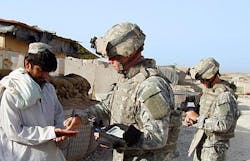Army asks industry to develop complex algorithms for handheld explosives detectors
FORT BELVOIR, Va., 18 Sept. 2012. U.S. Army researchers are reaching out to industry to find companies able to create complex computer algorithms to help deployed soldiers detect explosives such as land mines, improvised explosive devices (IEDs), and unexploded ordnance with handheld detectors.
The Night Vision and Electronic Sensors Directorate (NVESD) of the Army Research, Development and Engineering Command at Fort Belvoir, Va., issued a sources-sought notice (solicitation Number W909MY-12-R-B028) late last week for the Explosive Hazard Detection Algorithm Techniques for use in a Handheld Explosive Hazard Detection Field Data Acquisition System program.
This initiative seeks to identify state-of-the-art technology in industry and universities in explosives-detection algorithm techniques for potential use in a future handheld explosive hazard detection field data acquisition system.
Algorithms would help detect hazardous explosives buried as deep as 12 inches from about three inches off the ground. Algorithms also must operate on the output of one or more sensors, such as ground-penetrating radar, metal detectors, magnetometers, and electro-optic cameras.
Army researchers expect to design a multisensor explosive hazard detection system with sensors attached to a wand that will be swept over the ground. The system must include sensor head position tracking information. Researchers say they expect the detection algorithms eventually to result in high detection probability and low false alarm rate.
Companies interested should respond with white papers no later than 15 Oct. 2012 that describe the realistic application of their approach. Army officials caution that this is not a request for proposal.
E-mail white papers to the Army's Tonya Heyward at [email protected], with a copy to Marilyn Shortle at [email protected].
For questions or concerns contact The Army's Patricia Davis by phone at 703-704-0820, or by e-mail at [email protected].
More information is online at https://www.fbo.gov/notices/04f3c45c7121447648b41697e912a837.
Follow Military & Aerospace Electronics and Avionics Intelligence news updates on Twitter
